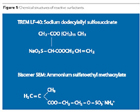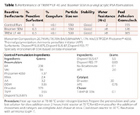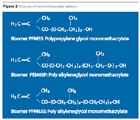The Use of Specialty Acrylate and Methacrylate Monomers in Emulsion Polymerization
The objective of this paper is to evaluate selected hydroxyl functional mono metha¬crylates, as well as reactive surfactants in emulsion polymerization (EP).
Some of the selected hydroxyl functional monomers are extensively used as reactive diluents for radiation-curable adhesives and coatings. They are also used as capping agents in urethane methacrylate oligomers for the production of photopolymer printing plates and dry film resists. In addition, they can be used in the production of acrylic polyols and urethane acrylate oligomers for use in photo imaging applications such as printed circuit boards. Other applications include the preparation of hydrogels, polyurethane dispersions, printing inks, water-reducible resins, etc. Now, the interest is to examine their incorporation characteristics, performance and benefits in emulsion polymerization.
Conventional (Non-Reactive) Surfactants
Emulsion polymerization technology has been discussed in a number of publications.1-4 The primary role of surfactants in EP is to lower the interfacial tension, which allows the emulsification of reactive vinyl monomers and the formation of stable colloidal dispersions of polymer particles. Conventional surfactants aid in the emulsification of monomers inside the micelles, stabilize the polymer particles during nucleation and growth, and promote the stability of the resulting latex.1-9 A fundamental property of surfactants is their ability to orient and adsorb at the interfaces. In latex systems, most of the surfactant is adsorbed at the interfaces between the particles and the water. This adsorption is a thermodynamic process favored by a decrease in the overall free energy of the system. The adsorbed layer of surfactant molecules is essential for the stabilization of latexes during polymerization and during post polymerization processes.It is well known that the amount and chemical structure of the surfactant/s used in EP have a strong influence on conversion, particle size and distribution, viscosity, overall latex stability and cleanness. Surfactants also have an effect on final properties such as film formation, adhesion, wet ability, water resistance and foamability. A critical issue in the manufacture of commercial latexes is their stability during and after production.
As mentioned before, surfactants have an effect on overall latex stability. The appropriate selection of surfactants is an important consideration when designing a latex formulation. The most effective and widely used surfactants in EP are anionics and nonionics. Anionic surfactants prevent coagulation by electrostatic repulsions originated from the anionic charges adsorbed on the polymer particles and their associated double layers. Nonionic surfactants, especially polyethoxylates, prevent coagulation by spatial or steric stabilization.10-15,22 Some specialty surfactants, such as fatty alcohol ether sulfates, combine both electrostatic and steric stabilization in their molecules. The experimental section contains examples.
Reactive Surfactants
Reactive surfactants can be covalently bonded to the polymer. The most apparent advantage of bonding to the polymer is the minimization or elimination of surfactant migration to the interfaces during film formation, which may increase water resistance, adhesion, latex stability and decrease foaminess. An extensive number of references have been provided elsewhere.16-20Reactive surfactants can be classified as surface-active initiators, i.e. surfactants with an initiating moiety (inisurfs); surfactants bearing a moiety capable of chain transfer (transurfs), or surfactants with a functional group capable of copolymerization (surfmers). This discussion is about surfmers, or reactive surfactants having at least one vinyl bond capable of reacting via free radical polymerization, and a surface-active moiety in their molecules. A caveat related to surfmers is the difference in surface activity shown during incorporation in EP. Some surfmers can be used as the sole reactive emulsifier to carry out a polymerization to full conversion. Others need to be combined with a co-surfactant to produce a stable polymer.
The next section summarizes results obtained using two reactive surfactants: TREM™ LF-40, a sodium dodecylallyl sulfosuccinate and Bisomer® SEM, an ammonium sulfatoethyl methacrylate (sulfated HEMA). TREM LF-40 has been the topic of numerous studies at Lehigh University.16-20 It can be used as the sole emulsifier to carry out a polymerization to full conversion. Bisomer SEM was found effective replacing up to 80% of a conventional anionic surfactant. Therefore, when using Bisomer SEM, at least 20% of a co-surfactant, typically anionic in character, would be needed to produce stable latexes. Combinations of Bisomer SEM and Disponil® FES 32, a fatty alcohol ether sulfate of composition C12-14, [4-ethylene oxide moles] Na sulfate, are very effective in the preparation of nanolatexes. It has also been observed that the incorporation of Bisomer SEM increased the overall stability and the water resistance of latexes. For example, the experimental session illustrates that latexes made with a combination of Bisomer SEM and anionic surfactants had better stability and water resistance than latexes made with a conventional anionic surfactant as the sole emulsifier.

Hydroxyl Functional Monomers
The hydroxyl functional monomers studied are adducts of polyethylene glycol or polypropylene glycol with hydroxyl monomers. They consist of a range of hydroxyl functional monomethacrylates with different molecular weights, different hydrophilic and hydrophobic characteristics, and different reactivity. The adducts evaluated have low glass transition temperatures (Tg), making them ideal for internal plasticization of polymers. The pendant hydroxyl functionality is suitable for further chemical modifications such as chain extension, grafting and crosslinking.
Experimental
Performance of Reactive Surfactants: Pressure Sensitive Adhesive FormulationTable 1 summarizes the performance of reactive surfactants TREM LF-40 and Bisomer SEM in a vinyl acrylic pressure sensitive (PSA) formulation. The results of incorporating these two reactive surfactants at 0.5% based on total monomer content is compared to the control polymerization run made without either of them. The chemical structures of the reactive surfactants are shown in Figure 1.
The incorporation of either reactive surfactant in the formulation did not have a noticeable effect on most of the physical properties of the latexes. The coagulum content, the viscosity and the particle size and distribution, as well as the overall stability were similar to those given by the control polymerization run. However, the water resistance was remarkably increased in latexes containing either reactive surfactant.
The water sensitivity was evaluated on latexes coated on untreated aluminum panels. Drops of water were placed on the surface of the coatings. The film appearance was recorded at several intervals during eight hours. A significant improvement in water resistance was observed in the coatings made with TREM LF-40 and Bisomer SEM.
The latexes were also coated on polypropylene film and laminated to the same. The peel adhesion was determined using an automated Thwing Albert peel tester.
The laminates made with the latexes containing reactive surfactants showed improved peel adhesion over the control. However, the improvement in water resistance was substantially higher than the improvement in peel adhesion.

Performance of Hydroxyl Functional Adducts in Architectural Coatings
Sabatier and Glaze21 reported the advantages of polypropylene glycol monomethacrylate, Bisomer PPM6E, as an internal plasticizing co-monomer in the preparation of low-VOC vinyl acrylics for paint binders. PPM6E was found to be effective as a partial or total replacement of low-Tg monomers such as butyl acrylate (BA) and vinyl versatate (VV10). The report illustrates the plasticizing efficiency of PPM6. It was shown that 8% of PPM6E was equivalent to 13% BA or 18% VV10. The vinyl acrylic binders were formulated with protective colloid (HEC) and several nonionic surfactants and stabilizers.The structures of the mono¬methacrylate adducts used in this study are shown in Figure 2. These are suitable alternatives to HEA and HPA, as they are non-toxic, easy-to-handle, low-viscosity clear liquids, and polymeric by EINECS classification.
Due to its propylene glycol segment, Bisomer PPM5S is the most hydrophobic of the monomers shown; its hydroxyl functional group is secondary. Bisomer PEM63P and PPM63E combine short ethylene glycol and propylene glycol blocks. Different combinations of glycol blocks provide different water/monomer solubility and reactivity. In addition, either PO/EO or EO/PO blocks present alternative pendant primary and secondary hydroxyl terminal functionalities. The primary hydroxyl is more reactive and may offer potential benefits to further crosslinking for scratch-resistant coatings.
This experimental section discusses the effect of replacing low-Tg monomer butyl acrylate with the described monomethacrylate adducts. These adducts have a plasticizing efficiency equivalent to a glass transition temperature of -70 °C (21), which make them very suitable to replace commercial internal plasticizing monomers such as 2-EHA, DOM and IOA. A significant benefit of using the adducts as internal plasticizing monomers could be the preparation of low-VOC acrylics and vinyl acrylics for architectural binders.
The vinyl acrylic latexes evaluated in this study were made without protective colloids. A current trend in the production of binders for architectural coatings is the ever-smaller particle sizes to improve film integrity, water and humidity resistance, as well as alkali resistance. The appropriate combination of anionic surfactant Disponil FES 77, a fatty alcohol ether sulfate of composition C12-14 with [30-ethylene oxide moles] Na sulfate, and nonionic surfactant Disponil AFX 4060, a modified fatty alcohol ethoxylate of composition C12-14 with [40-ethylene oxide moles], gave the desired particle size and distribution and overall stability. The long polyglycol ether hydrophilic moiety in these surfactants provided sufficient steric stabilization to produce stable latexes. The acrylic terpolymers were made using a very effective anionic surfactant, Disponil FES 32, which gives an excellent balance of desired particle size and overall latex stability.
In this study, several Bisomer adducts were evaluated in two model formulations, a vinyl terpolymer and an acrylic terpolymer. The control vinyl acrylic had a composition consisting of 76% vinyl acetate, 23% butyl acrylate and 1.5 % methacrylic acid. While the control acrylic had a composition of 51.5% methyl methacrylate, 47% butyl acrylate and 1.5% methacrylic acid. As mentioned before, a significant benefit of using the adducts as internal plasticizing monomers could be the preparation of low-VOC acrylics and vinyl acrylics for architectural binders.
To evaluate this potential benefit, some of the latexes were formulated into paints with and without coalescing agents in the formulation. Table 2 shows the effect of incorporating the three previously described Bisomer adducts in the model vinyl acrylic terpolymer. The concentration of the adducts replacing BA in the control latex is shown in the table. The latexes containing the adducts showed a decrease in the MFFT of approximately 8-7 °C.
All of the latexes were formulated into a flat paint formulation with and without coalescing agent. Preliminary results indicated that it is feasible to prepare good film-forming paints without coalescing agent.
Table 3 shows the effect of incorporating two previously described Bisomer adducts in a model acrylic terpolymer. It is important to point out that Disponil FES 32, a fatty alcohol ether sulfate of composition C12-14 [4-ethylene oxide moles] Na sulfate, is an effective surfactant to produce fine-particle-size latexes. However, the latex formulated with 1% surfactant concentration did not pass the freeze-thaw stability test. Typically, the freeze-thaw stability can be restored or obtained by post adding 1% of a steric stabilizer such as Disponil AFX 4060 or Disponil AFX 5060. Disponil AFX 4060 is a modified fatty alcohol ethoxylate of composition C12-14 [40-ethylene oxide moles]. Disponil AFX 5060 is a modified fatty alcohol ethoxylate of composition C12-14 [50-ethylene oxide moles].22 However, for some sensitive applications, the addition of surfactants after polymerization often produces undesirable water sensitivity, and therefore the evaluation of selected adducts may be appropriate.
As Table 3 shows, the latexes made by replacing 5% of BA with Bisomer adducts PEM63P and PPM5 passed the freeze-thaw test. Freeze-thaw is a very desirable physical property; thus, these results may be useful in designing formulations with improved F/T stability.

Summary
The reactive surfactants TREM LF 40 and Bisomer SEM were very effective in improving the water resistance of a PSA formulation. Plasticizing Bisomer adducts PPM5S, PEM63P and PPM63E were evaluated in a vinyl acrylic formulation for architectural coatings replacing 10% BA. The resulting latexes showed comparable overall stabilization to the control polymerization and decrease in MFFT of approximately 8-7 °C. Preliminary results indicate that it is feasible to prepare low-VOC and good film-forming paints without coalescing agent. Paints containing adduct PEM63P had improved wet ability as measured by the fewer defects observed in the films. In addition, the replacement of BA with Bisomer adducts PEM63P and PPM5 produced acrylic latexes with improved freeze-thaw stability. A significant benefit of using the adducts as internal plasticizing monomers could be the preparation of low-VOC acrylics and vinyl acrylics for architectural binders, the improvement of overall stability and in some instances the improvement in substrate compatibility and wet ability.
References
- Harkins, W.D. J.Am. Chem Soc. 1947, 69, 1428.
- W.V. Smith, W.V.; Edwards, R.H. J. Chem. Phys. 1948, 16, 592.
- Smith, W.V. J. Am. Chem. Soc. 1949, 70, 3695, 1948, ibid. 71, 4077, 1949.
- Blackley, D.C. Emulsion Polymerization. Applied; Sci. Publishers Ltd., 1975.
- Fernandez, A.M.; Evans, E.; Held, U.; Feustel, D.; Natale, M.; Tuttle, B.; Klima, R. International Waterborne Symposium, 1999.
- Piirma, I.,et.al. J. Polym. Chem. 1982, 20, 489.
- Piirma, I., et.al. Polym. Bulletin 1984, 11, 497.
- Medvedev, S.S., et.al. J. Macromol.Sci. Chem. 1973, 7, 715.
- Fernandez, A.M.; Saint Victor, M.E., et al. International Waterborne Symposium, February 2004.
- Okamura, S. et. al. J. Polym. Sci. 1962, 58, 221.
11 Fernandez, A.M.; Saint Victor, M.E., et al. Federation of Societies for Coatings Technology, October, 2004.
- Verwey, E.J.W.; Overbeek, J.G. Elsevier, 1948
- Naper, D.H. Sci. Prog. Oxford, 1967, 55.
- Napper, D.H. Trans. Faraday Soc. 1969, 64.
- Napper, D.H. J. Colloid. Interface Sci. 1970. 32.
- Sudol, E.D,; El-Aasser, M.S. Advances in emulsion polymerization and latex technology-EPI, Lehigh University.
- Urquiola, M.B.; Dimonie, V.L.; Sudol, E.D.; El-Aasser, M.S. J.Polym. Sci., Part A: Polym. Chem. 1992, 30, (2619 and 2631).
- Urquiola, M.B.; Dimonie, V.L.; Sudol, E.D.; El-Aasser, M.S. J.Polym. Sci., Part A: Polym. Chem. 1993, 31,1403.
- Wan, X. "Emulsion polymerization of styrene using a reactive surfactant".Ph. D. dissertation thesis, EPI, Lehigh University, 2000.
- Wan X.; Sudol, E.D.; El-Aasser, M.S. ACS Symposium Series, 2002.
- Sabatier, L.; Glaze, A.P. JOCCA, 1993.
- Fernandez, A.M. ; Saint Victor, M.E., et al., Federation of Societies for Coatings Technology, October, 2004.
Looking for a reprint of this article?
From high-res PDFs to custom plaques, order your copy today!







